

Nutrient Timing: A Garage Door of Opportunity? 1.

Introduction Nutrient timing is a dietary strategy in which specific nutrients are ingested at certain times surrounding training in order to bolster acute performance and/or chronic adaptations [1]. Rehabilitation Nutrition for Injury Recovery of Athletes: The Role of Macronutrient Intake. 5.1.
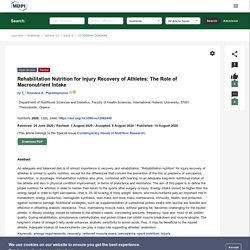
The Key Role of Protein Compensating anabolic resistance and aiming at optimizing the anabolic response to protein consumption in order to preserve muscle mass, and avoid body fat gain are nutritional challenges [13]. A significant amount of evidence indicates that milk-based protein after resistance exercise acts favorably on body composition and muscle strength [29,30]. A higher protein intake is related to muscle mass retention. Additionally, it has been noted that excess protein is metabolically difficult to be turned into fat, when there is no excess energy intake.
A review of the ketogenic diet for endurance athletes: performance enhancer or placebo effect? It has been hypothesized that consuming a ketogenic diet may enhance performance among endurance athletes by promoting a shift in substrate utilization that enhances physiological training benefits [3, 18].
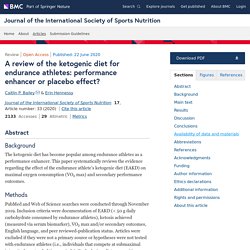
The present review explores this hypothesis by examining associations between EAKD consumption and VO2 max, a biomarker for endurance capacity [11]. Two of the seven studies included in this review found a significant increase in VO2 max post-EAKD consumption [7, 12]. However, both articles reported significant VO2 max increases across all diets, and that outcomes were independent of dietary intervention.
Interestingly, both studies were conducted among elite race walkers that self-selected their dietary intervention, and the athletes that self-selected into the EAKD had slightly higher average baseline and post-treatment VO2 max values [7, 12]. Plant‐based eating patterns and endurance performance: A focus on inflammation, oxidative stress and immune responses - Craddock - 2020 - Nutrition Bulletin. Nutrition-Related Adverse Outcomes in Endurance Sports Competitions: A Review of Incidence and Practical Recommendations.
1.

Introduction Endurance sport modalities requires competitors to complete a set distance or amount of work in the shortest time possible (time trial) or a maximal amount of work in a fixed amount of time [1] with the predominance of an energy metabolism dependent on oxidative processes [2,3]. In this sense the more important performance variables in endurance sport modalities is the maximal aerobic power, lactate threshold and economy [4] and the duration of the competition are higher than 5 min [1]. Is a vegan diet detrimental to endurance and muscle strength? Background/objectives In the general population, there is a popular belief that a vegan diet may be associated with a lower exercise performance due to the lack of certain nutrients in vegan individuals.
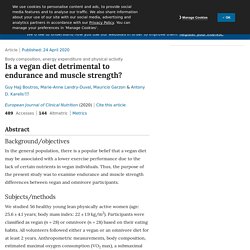
Thus, the purpose of the present study was to examine endurance and muscle strength differences between vegan and omnivore participants. Subjects/methods We studied 56 healthy young lean physically active women (age: 25.6 ± 4.1 years; body mass index: 22 ± 1.9 kg/m2). Participants were classified as vegan (n = 28) or omnivore (n = 28) based on their eating habits.
Wilderness Medical Society Clinical Practice Guidelines for the Management of Exercise-Associated Hyponatremia: 2019 Update - Wilderness & Environmental Medicine. Recommendation.
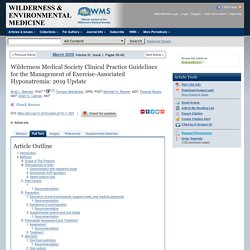
Athlete-Specific Treatment for Eating Disorders: Initial Findings from the Walden GOALS Program - Journal of the Academy of Nutrition and Dietetics. A Review of the Role of the Gut Microbiome in Personalized Sports Nutrition. Introduction The gut microbiome has been implicated in the modulation of human health and metabolism (1, 2).
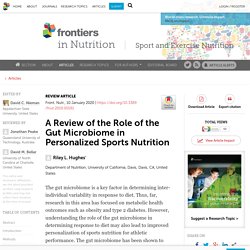
This microbial “organ” has been linked to nutrition-related chronic diseases such as obesity and diabetes (3–6) and has also been shown to influence systemic functions including immunity (7, 8) and brain function (9, 10). The gut microbiome may influence health via mechanisms such as the production of metabolites (2, 11) [e.g., short-chain fatty acids (SCFAs)] that can influence a wide array of host systems and metabolic pathways (12, 13). However, the gut microbiome is not a fixed trait, but instead responds to environmental stimuli and is a malleable part of the human supraorganism (14) (Figure 1).
Sports Dietitians Australia Position Statement: Nutrition for Exercise in Hot Environments in: International Journal of Sport Nutrition and Exercise Metabolism - Ahead of print. Ketogenic Diet: from the Historical Records to Use in Elite Athletes. Nutrition and Athlete Bone Health. Whilst, as mentioned above, many of the dietary requirements to support bone health in the athlete are likely to be largely the same as those supporting bone health in the general population, there are some dietary/nutritional challenges specific to the athlete.
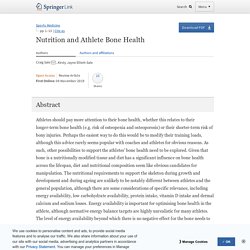
The remainder of this review will focus upon what we consider to be the most pertinent, namely: energy availability, low carbohydrate availability, protein intake, vitamin D intake and dermal calcium and sodium losses. The review will also briefly cover the effects of feeding around exercise on bone metabolism. 3.1 Energy Availability Energy availability can be described as the amount of ingested energy remaining to support basic bodily functions and physiological processes, including growth, immune function, locomotion, and thermoregulation, once the energy needed for exercise has been utilised [25].
Further research is also required to tease out the nuances of the effects of energy and nutrient availability on bone. Nutrition and Altitude: Strategies to Enhance Adaptation, Improve Performance and Maintain Health: A Narrative Review. Despite a growing body of evidence for a handful of specific ergogenic aids for performance enhancement at sea level [107], there are very few acute or chronic supplementation studies completed in hypoxic conditions.
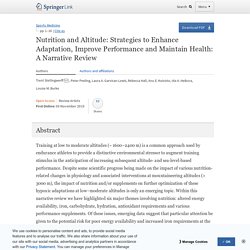
Given that hypoxia changes oxygen extraction, delivery and uptake, as well as altering lactate kinetics and buffering, we would caution against the indiscriminate use of sea-level ergogenic aids until more hypoxia-based data are generated. Nevertheless, there are some preliminary data on nitrate supplementation and some theoretical use of buffers at altitude, along with several other emerging supplements that will be covered in this section. 5.1 Nitrates/Beetroot at Altitude.
Nutrition and Athlete Immune Health: New Perspectives on an Old Paradigm. There has been much debate of late about the influence of energy deficiency on athlete health [58, 59].
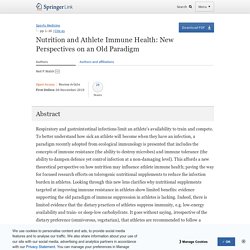
Interest in this topic has been stoked by the recent observation that low energy availability was associated with increased illness symptoms in elite female athletes [4, 5]. Besides the obvious limitation that this observation was restricted to female athletes, the authors recognised the need for studies to directly assess energy availability (they used the LEAF questionnaire) and perform measures of immunity and pathology, the latter to confirm infection. Ketogenic Diets and Exercise Performance. 1. Introduction Nutritional intervention and supplementation remain popular strategies for the reduction of body weight and/or for the enhancement of exercise performance.
Recently, the ketogenic diet (KD) has emerged as a celebrated dietary plan for the treatment of obesity and diabetes [1]. In addition to being used for weight and body composition management, KDs and/or “keto” supplements are a prominent point of interest within the athletic community for the potential promise as a “superfuel” [2,3]. Although the KD has been used successfully for certain health conditions, questions remain on the long-term impact of the diet on obesity, diabetes, and risk factors for cardiovascular disease (CVD). KDs are low-carbohydrate, high fat, moderate protein diets that typically supply approximately 80% of calories from fat, 15% calories from protein, and 5% calories from carbohydrates [4,5]. 2.
Intermittent Fasting and Its Effects on Athletic Performance... : Current Sports Medicine Reports. Introduction Intermittent fasting (IFast) refers to the idea of abstaining from eating food for a certain period during a day and consuming calories ab lib during the eating hours. The idea of IFast and its potential benefits has been around in a variety of ways for most of human history, especially in the setting of religion (1–3). The reported benefits of IFast include weight loss, reductions in blood pressure, and improvement in markers of metabolic disease risk (1,4–7). IFast has garnered more public attention with recent endorsements by celebrities and athletes, and it has been featured in numerous magazines, such as Time, Men’s Health, and Cosmopolitan. As the popularity of IFast increases, it is important for the health care physician to be able to counsel athletes on the effects of the IFast diet on athletic performance.
Several studies and reviews have looked at how the body reacts to fasting (8,10,11). Practical Hydration Solutions for Sports. What Should We Do About Habitual Caffeine Use in Athletes? Sport Nutrigenomics: Personalized Nutrition for Athletic Performance. Introduction Sport and exercise performance are significantly influenced by nutrition, yet individuals respond differently to the same foods, nutrients and supplements consumed. Plant-Based Diets for Cardiovascular Safety and Performance in Endurance Sports.
2014 Evidence-based recommendations for natural bodybuilding contest preparation: nutrition and supplementation. PubMed, MEDLINE, SPORTDiscus and CINAHL electronic databases were searched online. Each author was assigned a portion of the manuscript to write specific to their area(s) of expertise. 2014 Nutritional Management of the Bariatric Athlete : Bariatric Times. By Silvia Leite Faria, MSc, RD, PhD; Orlando Pereira Faria, md; Mariane de Almeida Cardeal; and Caroline Soares Menezes Silvia Leite Faria, MSc, RD, PhD; Orlando Pereira Faria, MD; Mariane de Almeida Cardeal; and Caroline Soares Menezes are from Gastrocirurgia de Brasília, Brasília, Brazil.
FUNDING: No funding was provided. DISCLOSURES: The author reports no conflicts of interest to the content of this article. Bariatric Times. 2014;11(10):10–14. ABSTRACT The aim of this article is to present a review of current literature on treating of the post-surgery influence of physical activity and, based on the findings, propose recommendations directly related to the needs of the physically active bariatric patient.
PA associated with a healthy diet provides more effective weight loss during short or long periods than either of them alone.[6,8] 2015 Consensus Recommendations on Training and Competing in the Heat. The development of hyperthermia during exercise in hot ambient conditions is associated with a rise in sweat rate, which can lead to progressive dehydration if fluid losses are not minimized by increasing fluid consumption. Exercise-induced dehydration, leading to a hypohydrated state, is associated with a decrease in plasma volume and an increase in plasma osmolality that are proportional to the reduction in total body water [19]. The increase in the core temperature threshold for vasodilation and sweating at the onset of exercise is closely linked to the ensuing hyperosmolality and hypovolemia [72, 73].
During exercise, plasma hyperosmolality reduces the sweat rate for any given core temperature and decreases evaporative heat loss [74]. 2015 Statement of the Third International Exercise-Associated Hyponatremia Consensus. The third International Exercise-Associated Hyponatremia (EAH) Consensus Development Conference convened in Carlsbad, California in February 2015 with a panel of 17 international experts. 2016 The Female Athlete Triad. 2017 “Eat as If You Could Save the Planet and Win!” Sustainability Integration into Nutrition for Exercise and Sport. 3.4.1. Plant Biodiversity—Diet Diversity. Factsheets Archive - Sports Dietitians Australia (SDA) Female Athlete Triad - ACOG. Dietary nitrate as modulator of physical performance and car... : Current Opinion in Clinical Nutrition & Metabolic Care.
Vegan diets: practical advice for athletes and exercisers. Nicotine: Sporting Friend or Foe? A Review of Athlete Use, Performance Consequences and Other Considerations. Nutrition Advice within Scope of Practice for AusREPs. Fitness Australia have introduced guidelines for AusREPs to follow when giving nutrition advice to clients, through the release of a Nutrition Advice within Scope of Practice for AusREPs. It’s designed to help AusREPs find the balance between providing the appropriate level of nutritional advice to the client, without providing information beyond their professional Scope of Practice The introduction of the guidelines is an important step for the Fitness Industry in providing quality services to clients Australia-wide. As part of the guidelines, AusREPs are encouraged to provide basic healthy eating information and advice through the application of nationally endorsed nutritional standards and guidelines – in particular, the Australian Dietary Guidelines.
The document gives AusREPs clear guidelines as to what services they can (and can’t) provide in the nutrition space, and when it’s most appropriate to refer clients on to an Accredited Practicing Dietitian.